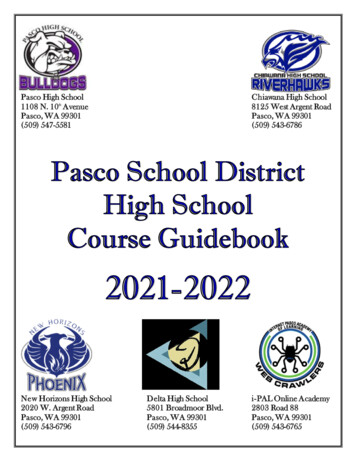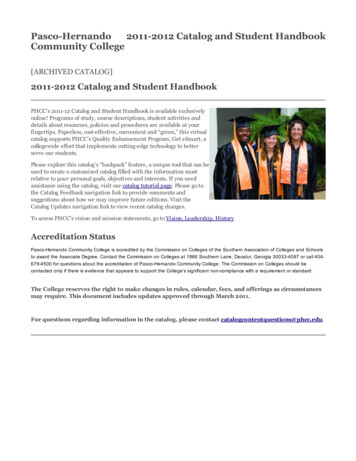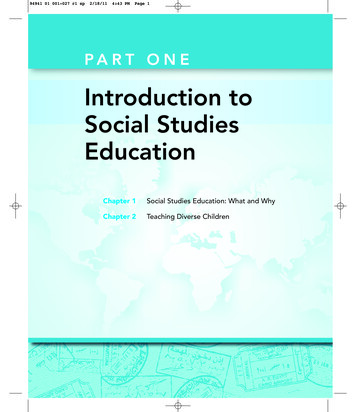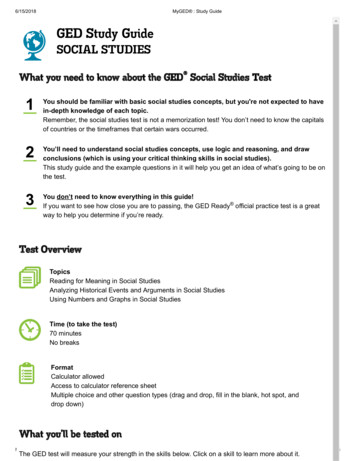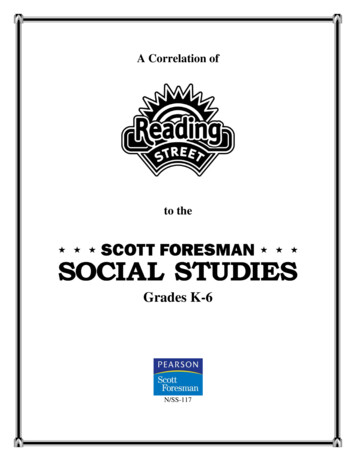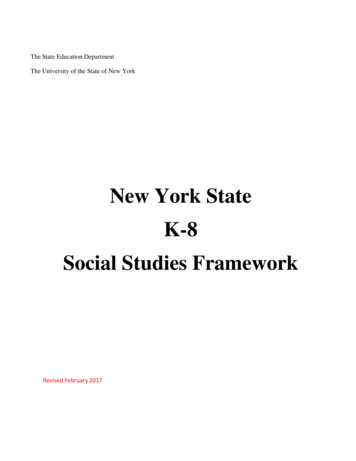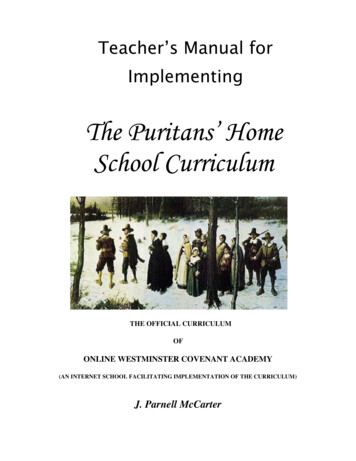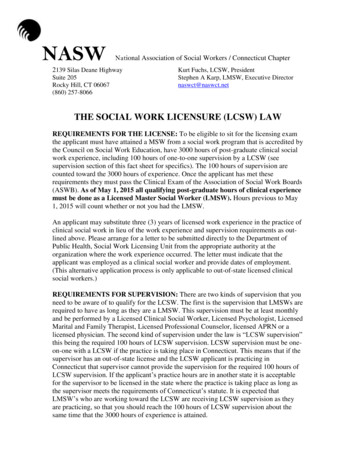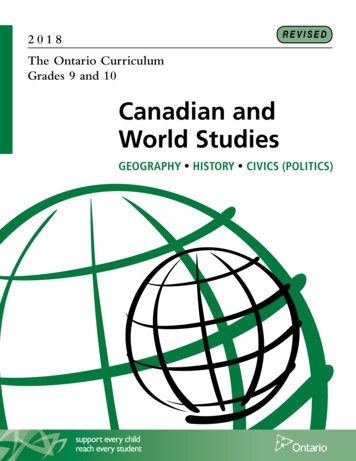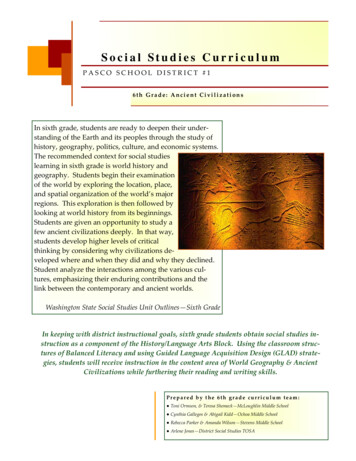
Transcription
S o c i a l St u d i e s C u r r i c u l u mPASCO SCHOOL DISTRICT #16th Grade: Ancient CivilizationsIn sixth grade, students are ready to deepen their under‐standing of the Earth and its peoples through the study ofhistory, geography, politics, culture, and economic systems.The recommended context for social studieslearning in sixth grade is world history andgeography. Students begin their examinationof the world by exploring the location, place,and spatial organization of the world’s majorregions. This exploration is then followed bylooking at world history from its beginnings.Students are given an opportunity to study afew ancient civilizations deeply. In that way,students develop higher levels of criticalthinking by considering why civilizations de‐veloped where and when they did and why they declined.Student analyze the interactions among the various cul‐tures, emphasizing their enduring contributions and thelink between the contemporary and ancient worlds.Washington State Social Studies Unit Outlines—Sixth GradeIn keeping with district instructional goals, sixth grade students obtain social studies in‐struction as a component of the History/Language Arts Block. Using the classroom struc‐tures of Balanced Literacy and using Guided Language Acquisition Design (GLAD) strate‐gies, students will receive instruction in the content area of World Geography & AncientCivilizations while furthering their reading and writing skills.Prepared by the 6th grade curriculum team: Toni Ormson, & Teresa Shemeck—McLoughlin Middle School Cynthia Gallegos & Abigail Kidd—Ochoa Middle School Rebecca Parker & Amanda Wilson—Stevens Middle School Arlene Jones—District Social Studies TOSA
Page 2World Geography & Ancient CivilizationsEstablished Goals for 6th Grade Social Studies:What significant contributions were made during ancient times that advancedscience, technology, and the arts?What do maps, globes, and charts teach us about the world?First SemesterMajor Projects/Assessments*World GeographyMesopotamiaAncient EgyptAncient GreeceSecond SemesterAncient ChinaMajor Projects/Assessments*“Humans & the Environment” District‐wideClassroom Based AssessmentAncient Rome* Projects vary from school to school in order to best serve the academic needs of the students whilemaintaining high standards.
PASCO SCHOOL DISTRICT #1Page 3W O R L D G E O G R A P H Y — A P X . 8 D AY SThis unit will focus on: The physical and cultural characteristics of places and regionsBy the end of the unit students will know: The five themes of geography Spatial patterns and how they are created What is a region and how are regions definedAt the end of the unit, students will be able to: Identify the location of places and regions in the world Identify parts of maps (scale, direction, symbols, legends, projections) and continents Construct and analyze maps using scale, direction, symbols, legends and projections to gather information.Core Vocabulary for this Unit:Contour MapsCoordinatesMinutesPhysical RegionsGlobal GridStudent’s knowledge will be assessed using the following:Core Materials for this Unit:Washington State Grade Level Expectations (GLEs):3.1.13.1.2Map EssentialsActivity 1Activity 2Activity 3Activity 4
World Geography & Ancient CivilizationsPage 4M E S O P O TA M I A — A P X . 2 2 D AY SThis unit will focus on: How and why rule of law develops in civilizations Understand a variety forms of government from the past or present Understand the role of government in the world’s economies through the creation ofmoney, taxation, and spending in the past or present How trade effects culture How have technology and ideas from ancient civilizations impacted world history What geographic factors stimulate the movement of goods, people & ideas.By the end of the unit students will know:How trade develops through surplusHow record-keeping was developed through commerceThe location of places and regions in the world and understands their physical and cultural characteristics. How the following inventions/developments have impacted civilization: the wheel, written language, irrigation The costs and benefits of economic choices made by groups an individuals in the past or present How the environment affects people and how people have affect the environment in in the past orpresent. At the end of the unit, students will be able to: Explain the concept of city-state Contrast governing of priest/kings Examine the effect government had on farmers through taxes Identify Mesopotamia as a region on a map Compare ancient Mesopotamia to modern day Iraq Evaluate the effect of irrigation on the ability of nomadic people to settle Analyze different cultural measures of time Discuss hierarchy of Mesopotamia social system Engage in a discussion that clarifies and addresses multiple viewpoints on public issues
PASCO SCHOOL DISTRICT #1Page 5Core Vocabulary for this Unit:Code of Hammurabi CuneiformEmpireStudent’s knowledge will be assessed using the following:Land UseWashington State Grade Level Expectations e Materials for this Unit:Map Essentials:Activities 5 & 7Harcourt;Ancient Civilizations:Unit 2—Chapter 3
World Geography & Ancient CivilizationsPage 6A N C I E N T E G Y P T — A P X . 2 2 D AY SThis unit will focus on: The legacies left by ancient civilizations, and their impact on our society How cultures and cultural groups in ancient civilizations contributed to world history How technology and ideas from ancient civilizations impacted world history The relationship between people and the environment in the past and present The distribution of wealth and sustainability of resources in the world in the past or present A variety of forms of government from the past or presentBy the end of the unit students will know: The similarities and differences between the rise of civilizations How ancient Egyptians moved large blocks of stone to build their pyramids Similarities and differences between cuneiform writing of Mesopotamia and hieroglyphics ofEgyptAt the end of the unit, students will be able to: Identify the location of places and regions in the world and understand their physical and culturalcharacteristics Explain the Egyptian impact o the Nile river and its impact on them. Analyze the patterns of the rise of Mesopotamian and Egyptian civilizations Analyzes and interprets historical materials from a variety of perspectives in ancient history
PASCO SCHOOL DISTRICT #1Page 7Core Vocabulary for this Unit:AridDeltaHieroglyphNation-StateStudent’s knowledge will be assessed using the following: Compare and contrast the Egyptian governmentwith the government in the US Illustrate the hierarchy of Egypt’s society into a social pyramid Label a Physical and Political map of AncientEgypt What if people today still believed in and preparedfor an afterlife like the Egyptians did. What wouldwe don differently?PharaohWashington State Grade Level Expectations e Materials for this Unit:Map Essentials:Activity 6Harcourt;Ancient Civilizations:Unit 2—Chapter 4
World Geography & Ancient CivilizationsPage 8A N C I E N T G R E E C E — A P X . 3 6 D AY SThis unit will focus on: How religion and government exercise authority over people A variety of forms of government from the past or present The historical origins of civic involvement The geographic factors which stimulate the movement of goods, people & ideas The production, distribution, and consumption of goods, services, and resources in societies from the past or in the present The characteristics of cultures in the world from the past or in the present The contributions of ancient Greece to the arts, math & scienceBy the end of the unit students will know: The evolution of democracy in Athens How individuals and movements from ancient civilizations have shaped world history The events of the Persian Wars and how they directly influenced Western Civilization.At the end of the unit, students will be able to: Analyze multiple factors, compare two groups, generalize, and connect past to present to formulatea thesis in a paper or presentation. Explain the importance of trade to the ancient Greeks Analyze multiple causal factors that shape major events in ancient history
PASCO SCHOOL DISTRICT #1Page 9Core Vocabulary for this Unit:AssemblyCommerceCultural BorrowingIsthmusMythPeninsulaStudent’s knowledge will be assessed usingthe following: Analyze the multiple factors which created the lasting impact of Greek mythology on today’s cultures. Analyze how Alexander influenced worldhistory with the spread of Hellenistic culture Explain the rights and responsibilities ofthe citizens of Athens.Population DensityWashington State Grade Level Expectations (GLEs):1.2.34.2.11.4.14.3.22.2.15.4.13.2.2Core Materials for this Unit:Map Essentials:Activity 8Harcourt;Ancient Civilizations:Unit 4—Chapters 8 & 9
World Geography & Ancient CivilizationsPage 10A N C I E N T C H I N A — A P X . 2 2 D AY SThis unit will focus on: How different economic systems effect people’s daily lives The forces of supply and demand and how they have affected international trade in the pastor present The role of government in the world’s economies through the creation of money, taxation,and spending in the past or present. How societies interacted with one another in the past or present How the rise in civilizations defined eras in ancient history The characteristics of cultures in the world from the past or in the present.By the end of the unit students will know: The effect of the Silk Road and silk monopoly on China’s economy How technology and ideas from ancient civilizations have impacted world history The similarities and differences between the rise of Ancient Chinese civilization and other ancientcivilizations How individuals and movements from ancient civilizations have shaped world historyAt the end of the unit, students will be able to: Summarize the importance of the Silk Road to the distribution of supplies & information intoWestern Culture Contrast government’s role in economy (e.g. common currency) with Mesopotamian economy (nocommon currency) Construct and analyze maps using scale, direction, symbols, legends and projections to gather information.
PASCO SCHOOL DISTRICT #1Page 11Core Vocabulary for this Unit:DialectFilial pietySilk RoadTerrace farmingMandate ofHeavenStudent’s knowledge will be assessed using thefollowing: Create a topographical, political or populationmap of China Name at least 5 characteristics of ChineseCulture Analyze the impact of Confucius’ teachingsand the teachings of Buddhism on the worldpast and present Identify technological advances of ancientChina and their impact on the modern world.Washington State Grade Level Expectations e Materials for this Unit:Map Essentials:Activities 10 & 18Harcourt;Ancient Civilizations:Unit 5—Chapter 11
World Geography & Ancient CivilizationsPage 12A N C I E N T R O M E — A P X . 3 1 D AY SThis unit will focus on: How the movement of ideas, goods and people affect cultures How geographic factors influenced the movement of groups of people in the past or present How societies have interacted with one another in the past or present The role of government in the world’s economies through the creation of money, taxation,and spending in the past or present Analysis of how individuals and movements from ancient civilizations have shaped world history Analysis of how cultures and cultural groups in ancient civilizations contributed to worldhistory. How technology and ideas from ancient civilization impacted world historyBy the end of the unit students will know: The geographical factors that led to the establishment and growth of the Roma Empire How the use of slaves benefit/impact Roman societyAt the end of the unit, students will be able to: Explain how Rome conquered Greece and how it impacted both societies Explain how individuals like Julius Caesar and Augustus helped shape world history Examine the impact of the aqueduct on today’s plumbing
PASCO SCHOOL DISTRICT #1Page 13Core Vocabulary for this Unit:AqueductCensusCurrencyHeirStudent’s knowledge will be assessed using thefollowing: Describe the Roman government tax policyand relate it to your life.Washington State Grade Level Expectations (GLEs):1.3.14.2.12.3.14.2.23.2.34.2.3Core Materials for this Unit:Map Essentials:Activity 9Harcourt;Ancient Civilizations:Unit 6—Chapters 12 & 13
Oral Language FocusReadingFocusSpellingWriting Focus#Instr daysSocial Studies UnitEvents thattake awayinstructiontimeMonthsNarrative WritingSeptemberOctoberNDSWINTERJanuaryB 19/19RAncient Greece E(32 days)A3 days/lesson K14/14DecemberPersuasiveOrExpository1NovembersMAP testing QRI/MFC5-Early 1822/22R 18/15.5TWorld Ge- MesopotamiaE Ancient Egyptography(22 days)R (22 days)(8 days)4.5 days/5.5 days/lessonlessonEAugustE AncientN ChinaD (22 days)4.5 days/lesson3AprilrWASL 3dWeeksNDS5-Early release(Conferences)SUPERAQWriting PromptU(tbd)A20/16.5R 20/15TE Ancient RomeR (31 days)4.4 days/E lessonMarchPersuasiveOrExpositoryS FebruaryEWLPTMSUPERAESTER 19/18CBA18/15QRI/MFCMAP testingMay9/9June
Page 3 PASCO SCHOOL DISTRICT #1 WORLD GEOGRAPHY—APX. 8 DAYS This unit will focus on: The physical and cultural characteristics of places and regions By the end of the unit students will know: The five themes of geography Spatial patterns and how they are created What is a region and how are regions
